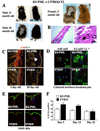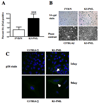The human promyelocytic leukemia protein is a tumor suppressor for murine skin carcinogenesis
- PMID: 19058256
- PMCID: PMC2711034
- DOI: 10.1002/mc.20498
The human promyelocytic leukemia protein is a tumor suppressor for murine skin carcinogenesis
Abstract
Expression of the PMLRARalpha fusion dominant-negative oncogene in the epidermis of transgenic mice resulted in spontaneous skin tumors attributed to changes in both the PML and RAR pathways [Hansen et al., Cancer Res 2003; 63:5257-5265]. To determine the contribution of PML to skin tumor susceptibility, transgenic mice were generated on an FVB/N background, that overexpressed the human PML protein in epidermis and hair follicles under the control of the bovine keratin 5 promoter. PML was highly expressed in the epidermis and hair follicles of these mice and was also increased in cultured keratinocytes where it was confined to nuclear bodies. While an overt skin phenotype was not detected in young transgenic mice, expression of keratin 10 (K10) was increased in epidermis and hair follicles and cultured keratinocytes. As mice aged, they exhibited extensive alopecia that was accentuated on the C57BL/6J background. Following skin tumor induction with 7, 12-dimethylbenz[a]anthracene (DMBA) as initiator and 12-O-tetradecanoylphorbol-13-acetate (TPA) as promoter, papilloma multiplicity and size were decreased in the transgenic mice by 35%, and the conversion of papillomas to carcinomas was delayed. Cultured transgenic keratinocytes underwent premature senescence and upregulated transcripts for p16 and Rb but not p19 and p53. Together, these changes suggest that PML participates in regulating the growth and differentiation of keratinocytes that likely influence its activity as a suppressor for tumor development.
Figures






References
-
- Hansen LA, Brown D, Virador V, et al. A PMLRARA transgene results in a retinoid-deficient phenotype associated with enhanced susceptibility to skin tumorigenesis. Cancer Res. 2003;63(17):5257–5265. - PubMed
-
- Melnick A, Licht JD. Deconstructing a disease: RARalpha, its fusion partners, and their roles in the pathogenesis of acute promyelocytic leukemia. Blood. 1999;93(10):3167–3215. - PubMed
-
- Everett RD. DNA viruses and viral proteins that interact with PML nuclear bodies. Oncogene. 2001;20(49):7266–7273. - PubMed
-
- Koken MH, Linares-Cruz G, Quignon F, et al. The PML growth-suppressor has an altered expression in human oncogenesis. Oncogene. 1995;10(7):1315–1324. - PubMed
-
- Gurrieri C, Capodieci P, Bernardi R, et al. Loss of the tumor suppressor PML in human cancers of multiple histologic origins. Journal of the National Cancer Institute. 2004;96(4):269–279. - PubMed
Publication types
MeSH terms
Substances
Grants and funding
LinkOut - more resources
Full Text Sources
Medical
Research Materials
Miscellaneous

